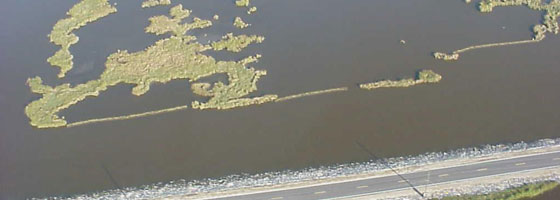Louisiana’s wetlands, culture have hope in floating islands

Louisiana’s wetland coast is expanding with the help of America’s favorite product: plastic. Nearly 1,500 linear feet of floating plant “islands,” made of recycled plastic bottles and foam, are flourishing off the coast of Houma, La. Local volunteers and a collaboration of businesses and non-profits launched the islands in September in an effort to reduce erosion and expand wetland area.
The floating islands, created by Martin Ecosystems of Baton Rouge, are 8 to 10 inches thick and hold 40 to 60 native plants each. The roots will grow through the mats and anchor into the bottom of the marsh where they will collect debris and organic matter. Land will begin to form as the matter builds up, fortifying the marsh. The first report of the islands in late October showed that the roots have grown through the mats and the plants have grown 2 feet since the original launch.
“After the first months, the signs are great,” said Buddy Boe, project manager with America’s Wetland Foundation (AWF) in New Orleans. “We’re not expecting land until the second or third growing season.”
Volunteers launched the islands in four different locations. In two of the locations, the islands buttress against the open-water side of existing marshes. They will allow these marshes to grow back, protecting them from storm and tide surges. The other two locations are strings of islands in open water. Project coordinators hope that these will also take root to form more land.
“The open water string is what’s really being watched by all of us to see if these islands can survive by themselves,” Boe said.
The AWF pushes a “multiple lines of offense” strategy to restore Louisiana’s coastland, which loses 25 square miles every year. This is partly because there are many causes that lead to its destruction. The Mississippi River, which carves the eastern state line of Louisiana, naturally floods every spring, depositing sediment that builds land along the coast. Over the years, locals built canals and levees, altering the natural cycle of the river that helped sustain the land. In 2005, Hurricane Katrina took 200 square miles of land in her wake. The Louisiana government adopted a comprehensive plan to restore the delta area, including reconnecting the river to the delta. Other solutions include pipeline diversions and spillways.
“We know there is not one solution that is the smoking gun of all of our restoration issues,” Boe said.
Though the floating island project is only one solution to coastline deterioration, its restoration payoffs are twofold. Before it was touched for industrial purposes, the land near the project in Terrebonne Parish was a fruitful home to Native American tribes. Part of the AWF’s mission is to protect natural resources as well as native cultures.
“Louisiana’s Native American communities have lost so much land that a part of the state’s historical heritage is threatened,” said Valsin A. Marmillion, managing director of the AWF, in an AWF press release. “Our America’s Energy Coast Task Force adopted a ‘no net loss of culture’ standard, calling on policy makers to ensure that coastal restoration includes maintaining our rich native culture. If we lose this land, it will be an American tragedy.”
On the floating island launch day, more than 350 local volunteers turned out, including Native American chiefs, elementary school students and government officials.
“People in Louisiana hear about restoration projects every day, many with logos attached to them, but you get culture involved and people listen,” Boe said.
Image credits: America’s Wetland Foundation





0 comments